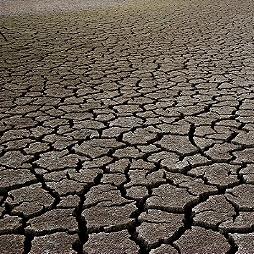Posted 17 May 2012

Deep cracks in soil that appear during long dry spells can remain open underground even after they have visibly sealed on the surface, a new study has found.
The results could have important implications for agricultural management around the timing and intensity of water and pesticide applications.
"These soils are very fertile and provide the most productive agricultural land in Australia," said lead author Dr Anna-Katrin Greve, a postdoctoral fellow with the Connected Waters Initiative.
"Lower water application intensity will give soil cracks time to close and more frequent irrigations could prevent the soil cracks from reforming."
These cracks, which form during extended dry periods, provide "preferential pathways" allowing water to flow much faster than it would through non-cracked soil.
This means nutrients and pesticides are rapidly transported beyond the crops' root-zone, said Greve, and if the plants can't access the water it has effectively been wasted.
By sending an electrical current through the ground at different angles, the UNSW researchers can measure directional differences in current conduction, which offers clues about how water is moving through the soil.
This innovative technique means they can, for the first time, detect the exact time when preferential sub-surface pathways close. This is important for irrigators, as water flow through non-cracked soil is far more predictable.
Their findings, which have been accepted for publication in the journal Geoderma, reveal that surface appearances can be deceiving.
"We showed that soil cracks that developed in dry periods remain open as preferential flow paths, even after the cracks are visually closed," said Greve.
Researchers measured the flow of electrical current through a soil profile that was set-up over several years. The soil was contained in a fiberglass barrel, which had a small drain at the base.
Two irrigation events were carried out approximately 14 days apart. Each event used water from different sources, meaning the two samples had different stable isotope signatures, allowing researchers to distinguish between them.
At the time of the first irrigation event there were visible cracks upwards of three centimetres wide in the soil. By the time of the second irrigation, these cracks had visibly closed.
Despite this surface closure, the water from the second irrigation actually drained faster. It bypassed the sections of the soil where water from the first event was presumably stored and drained with signs of limited mixing, researchers said, meaning preferential flow paths must have remained open.
Greve's study was awarded best paper at a geoscience conference in Europe in 2011 and she recently presented her findings at a conference in Arizona.
Links

Professor Andy Baker features in American Water Resources Association ‘Water Resources Impact’, September 2020 edition.

The Connected Waters Initiative (CWI) is pleased to welcome Taylor Coyne to its network as a postgraduate researcher. If you’re engaged in research at a postgraduate level, and you’re interested in joining the CWI network, get in touch! The CWI network includes multidisciplinary researchers across the Schools of Engineering, Sciences, Humanities and Languages and Law.

The Grand Challenge on Rapid Urbanisation will establish Think Deep Australia, led by Dr Marilu Melo Zurita, to explore how we can use our urban underground spaces for community benefit.

On the 21 August 2020, CWI researchers made a submission to the National Water Reform Inquiry, identifying priority areas and making a number of recommendations as to how to achieve a sustainable groundwater future for Australia.

Results published from a research project between the Land Development Department (LDD) Thailand and UNSW has demonstrated how 2-dimensional mapping can be used to understand soil salinity adjacent to a earthen canal in north east Thailand (Khongnawang et al. 2020).